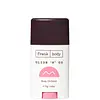What's inside
What's inside
 Key Ingredients
Key Ingredients

No key ingredients
 Benefits
Benefits

 Concerns
Concerns

 Ingredients Side-by-side
Ingredients Side-by-side

Cocos Nucifera Oil
MaskingBeeswax
Emulsion StabilisingButyrospermum Parkii Butter
Skin ConditioningCaprylic/Capric Triglyceride
MaskingTheobroma Cacao Seed Butter
EmollientCopernicia Cerifera Wax
Persea Gratissima Oil
Skin ConditioningRosa Canina Fruit Oil
EmollientPaullinia Cupana Seed Extract
Skin ConditioningGlycine Soja Oil
EmollientBanksia Serrata Flower Extract
Skin ConditioningDavidsonia Jerseyana Fruit Extract
AntioxidantCoffea Arabica Seed Extract
MaskingTasmannia Lanceolata Fruit Extract
Skin ConditioningGlycerin
HumectantTocopherol
AntioxidantParfum
MaskingWater
Skin ConditioningTetrasodium Glutamate Diacetate
Phenoxyethanol
PreservativeBenzyl Alcohol
PerfumingEthylhexylglycerin
Skin ConditioningSodium Benzoate
MaskingCocos Nucifera Oil, Beeswax, Butyrospermum Parkii Butter, Caprylic/Capric Triglyceride, Theobroma Cacao Seed Butter, Copernicia Cerifera Wax, Persea Gratissima Oil, Rosa Canina Fruit Oil, Paullinia Cupana Seed Extract, Glycine Soja Oil, Banksia Serrata Flower Extract, Davidsonia Jerseyana Fruit Extract, Coffea Arabica Seed Extract, Tasmannia Lanceolata Fruit Extract, Glycerin, Tocopherol, Parfum, Water, Tetrasodium Glutamate Diacetate, Phenoxyethanol, Benzyl Alcohol, Ethylhexylglycerin, Sodium Benzoate
 Reviews
Reviews

Ingredients Explained
These ingredients are found in both products.
Ingredients higher up in an ingredient list are typically present in a larger amount.
This ingredient is also known as shea butter. It is an effective skin hydrator and emollient.
Emollients help soothe and soften your skin. It does this by creating a protective film on your skin. This barrier helps trap moisture and keeps your skin hydrated. Emollients may be effective at treating dry or itchy skin.
Shea butter is rich in antioxidants. Antioxidants help fight free-radicals, or molecules that may harm the body. It is also full of fatty acids including stearic acid and linoleic acid. These acids help replenish the skin and keep skin moisturized.
While Shea Butter has an SPF rating of about 3-4, it is not a sunscreen replacement.
Shea butter may not be fungal acne safe. We recommend speaking with a professional if you have any concerns.
Learn more about Butyrospermum Parkii ButterThis ingredient is an emollient, solvent, and texture enhancer. It is considered a skin-softener by helping the skin prevent moisture loss.
It helps thicken a product's formula and makes it easier to spread by dissolving clumping compounds.
Caprylic Triglyceride is made by combining glycerin with coconut oil, forming a clear liquid.
While there is an assumption Caprylic Triglyceride can clog pores due to it being derived from coconut oil, there is no research supporting this.
Learn more about Caprylic/Capric TriglycerideCocos Nucifera Oil is obtained from the kernels of the coconut fruit. In other words, this is coconut oil.
Coconut Oil is rich in fatty acids with lauric acid making up the majority of these. It also contains linoleic acid. Due to this high fatty acid content, coconut oil helps trap moisture and soften skin.
Despite being antibacterial, coconut oil may not be great for acne-prone skin. It is comedogenic and may clog pores. This ingredient may not be safe for malassezia or fungal acne.
Note: Coconut Oil should not replace your sunscreen for UV protection. Studies show it only blocks about 20% of UV.
This oil is non-volatile and has a light scent.
The term 'fragrance' is not regulated in many countries. In many cases, it is up to the brand to define this term. For instance, many brands choose to label themselves as "fragrance-free" because they are not using synthetic fragrances. However, their products may still contain ingredients such as essential oils that are considered a fragrance.
Learn more about Cocos Nucifera Oil